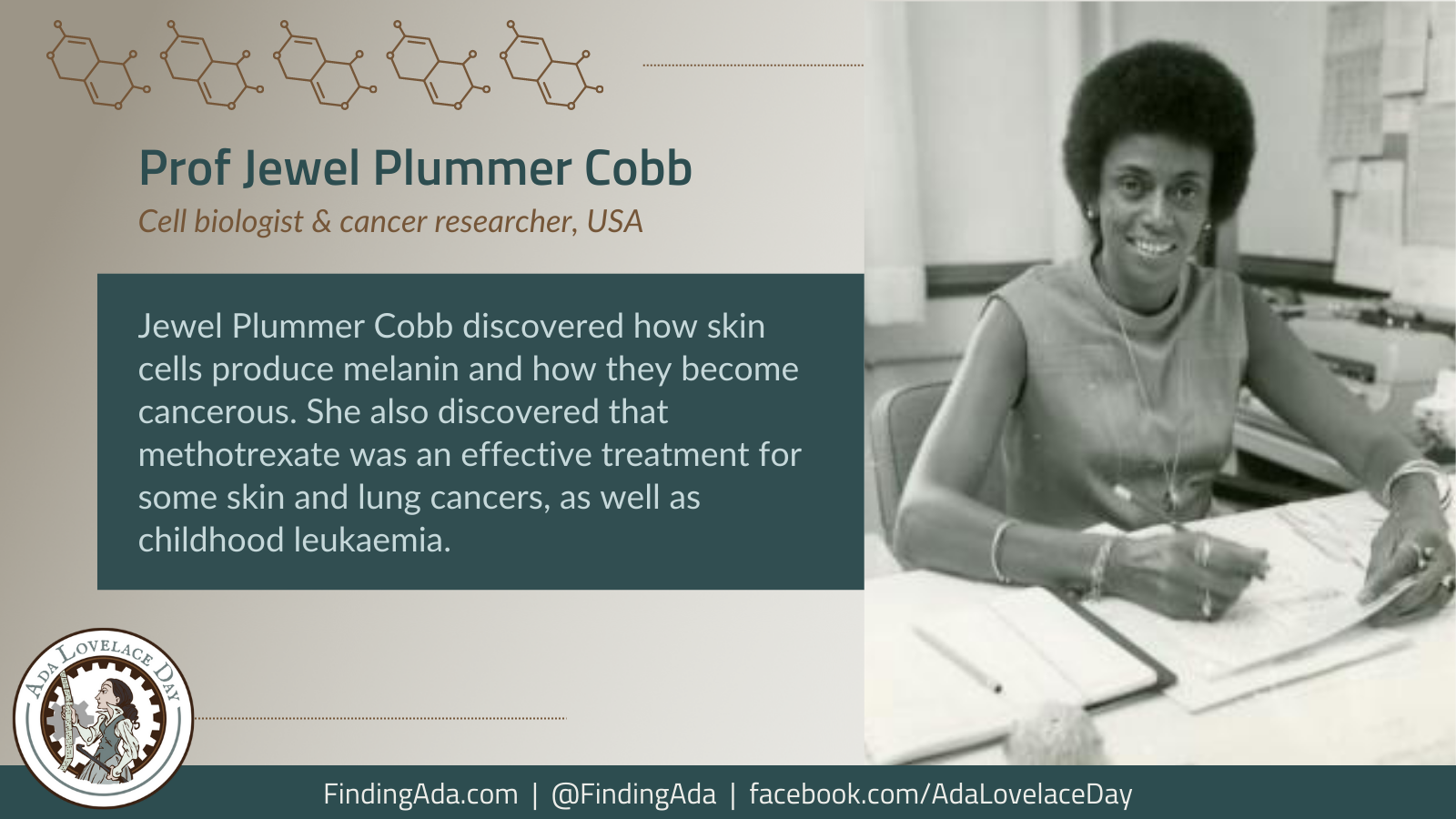
Professor Jewel Plummer Cobb
Jewel Plummer Cobb was a biologist who discovered how skin cells produce melanin and how they become cancerous. She also discovered that methotrexate was an effective treatment for some skin and lung cancers and childhood leukaemia.
Born in 1924 in Chicago, Cobb graduated from Talladega College in Alabama with a degree in biology in 1944, earning her master’s and then her doctorate in cell physiology from New York University. Her research focused on understanding how skin cells produce melanin and how those cells become cancerous. Her doctoral thesis, Mechanisms of Pigment Formation, examined the enzyme tyrosinase, which is required for skin cells to produce melanin, which is what causes colour in human skin.
After finishing her PhD, she spent two years at the Harlem Hospital Cancer Research Center where she developed a deep understanding of how to culture human tissue directly from a sample taken from a person. Few people understood these techniques in the 1950s. She became skilled at culturing cancer cells taken from patient biopsies and used these cultures to study the effect of various chemotherapy drugs on the cells’ morphology, migration and growth.
In 1952, she started her own laboratory which was the first tissue culture-based lab at the University of Illinois Medical School. She combined her early research on skin pigmentation and melanin with her newer work on cancer.
Two years later, she moved her lab back to Harlem, and began working with Jane Wright to study the effect that chemotherapy drugs had on melanoma, a type of skin cancer. Wright worked with the patients, and Cobb worked with cells cultured from the patients’ samples. They realised that Cobb’s results could help predict which treatments would work for each patient and type of cancer. Cobb used non-cancerous tissue samples as controls, something which wasn’t common practice at the time because it was so hard to culture non-cancerous cells.
In the early 1960s, Cobb and Wright showed that methotrexate was effective for treating several cancers, including skin and lung cancer, and childhood leukaemia. Cobb also worked with mice that had been bred to be more susceptible to skin cancer, and discovered that cells with more melanin were protected from damage caused by exposure to radium and X-rays. This was the first evidence that melanin protects cells from UVA/UVB light.
In 1969, Cobb became the first black dean at Connecticut College, where she began programs to encourage women and people of colour to study STEM and explore STEM careers. She later became the first black woman to be appointed to the National Science Board, which supervises the National Science Foundation.
Cobb died in 2017, aged 92.
Further Reading
- Jewel Plummer Cobb, Wikipedia
- Jewel Plummer Cobb (1924-2017), Diana Kenney, The University of Chicago: Marine Biological Laboratory
- Jewel Plummer Cobb, Connecticut Women’s Hall of Fame, 2008
- Jewel Plummer Cobb, Valerie Bradley-Holliday, Black Past, 16 March 2011
- Unsung: Jewel Plummer Cobb, Sibrina Nichelle Collins, Undark, 2 February 2017
- Jewel Plummer Cobb, 92, Dies; Led a California Campus, Daniel E. Slotnik, The New York Times, 11 January 2017
- Women in Science: Jewel Plummer Cobb (1924-2017), Dr Ellen Elliott, The Jackson Laboratory, 14 May 2018
- Jewel Plummer Cobb, Caroline Edwards, Project Biodiversity, 12 December 2019
- Jewel Plummer Cobb (1924-2017), Diana Kenney, The University of Chicago: Marine Biological Laboratory